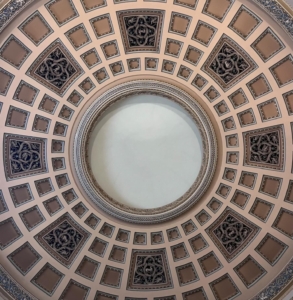Since ’tis the season, a not so brief explanation is in order.
Just like their mythological counterparts, eclipses have a hidden, sinuous effect.
From an astronomical perspective, they are a paradox: though they seem like an anomaly, they are actually a perfection of the orbital Sun Moon and Earth system. Were the system perfect each time, every full and new moon would be an eclipse. However, the orbits don’t intersect for most of the time, giving us on average 8 full and 8 new moons in a year.
The points at which the system perfects are the Lunar Nodes, which are immaterial, mathematical points, but which still have a very felt pull on us. They function on an axis, which is always 180 degrees apart.
Throughout the modern astrological tradition, the Nodes are described as being a karmic trajectory. The objection to that is if we understand the underlying principles of astrology, the whole chart is karmic.
In the Vedic tradition, the Nodes are two parts of what used to be the same being. Austin Coppock explains the mythology behind it:
“At the beginning of time, everything was liquid and semi-chaotic. The classes of beings called Devas and Asuras had to work together to churn the Great Sea and make Creation continue. Out of this liquid protomatter chunks of solid reality would form.
The churning process resulted in the coagulation of the amrita, the immortal food. Once the divine nature of this product was discovered, they argued over it. The Serpent King – head of the Asuras, sneakily drank from it, but was seen by Surya – the Sun, so the Serpent King swallowed him. Chandra – the Moon – sees this and gets swallowed too. Vishnu comes and slices him in two with a chakram, but due to the amrita he does not die. Instead each of the parts became separate entities. The Devas place the Head and Tail beneath the quantum ocean so they cannot be together, keeping everything in motion, stirring the batter out of which reality is cooked.”
While there are other versions of this story, the root idea persists: the Head and Tail are a class of powerful beings, contrary to the Devas. And as the story, the Nodes move counterclockwise through the zodiac, moving beneath the waters as shadows. Though they are not always dragons, mythology is filled with stories of monsters devouring the Sun and Moon, spanning many cultures.
And if we think about it, they are the most dramatic thing to happen in the sky, an inversion of natural order. Light suddenly disappears, the beacon is darkened. This is why many ancient cultures saw them as a malefic thing.
Having irregular periods of motion, they take 18.6 years to circle through the zodiac, spending about a year and a half in each sign.
Because they are at opposing parts of an axis, the Nodes operate simultaneously, and just like a head and a tail, one entangles and the other disentangles, in a complementary relationship. They are different kinds of darkness, one that goes blind from going in too deep, and the other that separates from that which exists.
The Head is always hungry for more, it increases things and puts a cape on any planet it is with, giving it power, while the Tail decreases things, slapping away at form and decreasing function and form.
In a chart, this describes the areas of life where we tend to overdo it with the Head, and the one where we want to pull away, for the Tail. Because the Tail is so connected to the past, we often find here things like innate natural talents, and sometimes bad luck in the area it’s connected to.
According to some principles of evolutionary astrology, we should dive in and encourage the North Node, the Head of the Dragon. However, an argument can be made here against this concept as the Vedic tradition – into which the tale of the Dragon is related – which has worked the longest and considers the Head and Tail as parts of the traditional bodies (of shadows in this context, chaya grahas), consider the North Node to be contrary to dharmic activity, as it creates more attachment and thus keeps us longer on the Wheel of Samsara.
In practice and transits, the Nodes create obscurity, confusion and obsession. They pull towards the mysterious and work beneath the surface with effects which only show up during eclipses, when the invisible overcomes the visible.
It is during eclipse season when things get distorted, when the insubstantial things impact the substantial world. Though not necessary physical events, eclipses are times when we have sudden deep realizations about specific areas of our lives. Things disappear that are supposed to be there, be it on a physical level, or on a psychological one, or we’re pulled with obsessive intensity towards a certain thing. Though not always disastrous, on a mundane level, eclipses have been long known to wreak havoc. being observed at pivotal times in history.
The story weaved by an eclipse cycle usually lasts about a year and a half, but as any event in our lives, the effects can be felt long afterward, when the the points that were eclipsed are activated by transit. However, during the time the Nodes are present on an axis we see with certainty both an intensification, a hunger, in one area, and disgust or decrease with the other. It can be the axis of ourselves/our relationships, of our career/our private life, or even that of our physical/mental health, but the tension will be there.



What a fantastic resource! The articles are meticulously crafted, offering a perfect balance of depth and accessibility. I always walk away having gained new understanding. My sincere appreciation to the team behind this outstanding website.